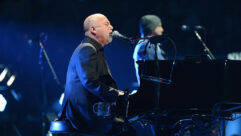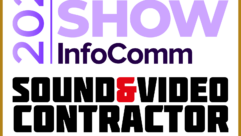
In this edition of the SVC Podcast, SVC Contributing Editor Bennett Liles talks with Wes Mathew of Puresound in Houston, Texas, about the way Puresound performs a 1-hour setup for the huge Breakaway Ministries congregation in Reed Arena and Kyle Field football stadium on the campus of Texas A&M University. Puresound uses a JBL Vertec line array sound system for the events in both venues but sets it up differently for separate coverage requirements. Mathew has some comments on how he uses his crew of two full-time people and 15 volunteers.
Links of interest:
- Puresound in Houston, Texas providing AV consultation, sales and rentals
- JBL VT4887 line array speaker unit
- The DrivePack amplifier module
Download Podcast Here:
https://s3.amazonaws.com/nb-svc/public/public/10_3_13-Puresound_Wes-Math…
Sep 10, 2013 10:58 AM,
With Bennett Liles

Listen to the Podcasts
Editor’s note: For your convenience, this transcription of the podcast includes timestamps. If you are listening to the podcast and reading its accompanying transcription, you can use the timestamps to jump to any part of the audio podcast by simply dragging the slider on the podcast to the time indicated in the transcription.

When Breakaway Ministries, a massive Bible study congregation, meets on the campus of Texas A&M, Puresound from Houston has 1 hour to load in, set up the whole sound system, and get the full band ready. Wes Mathew is going to tell us how he uses JBL Vertec line arrays and a nimble crew to get it all done in time, coming up next on the SVC Podcast.
SVC: Wes, glad to have you with us on the SVC Podcast from Puresound in Houston. Breakaway Ministries is an outfit that has grown to need venues like Texas A&M’s Reed Arena and Kyle Field football stadium to meet and when they do it everything has to be set up and struck real fast by your outfit, Puresound. Tell me about Puresound. What kind of outfit is it and what sort of stuff do you do?
Wes Mathew: Puresound, we’re a small business out here in Houston, Texas and we started in Austin, Texas actually probably about 15 years ago, and it was all for fun and games. And I’m actually a musician, I’m a drummer and percussionist, and currently still a drummer/percussionist, and all the bands in Austin needed an audio guy and so this is how it began. I just started providing audio for live productions, some partners bought in and it kind of grew and now we have probably 10 to 15 contractors under us. And so currently we do installations, 90 percent of our clients are churches, and also live production work, which includes churches—Breakaway is one of our clients—and also corporate events.
Well, churches are always needing some kind of AV support. They’re a perpetual AV market and it goes from the most modest setups to big broadcast outfits. Now Breakaway Ministries started with just a few people getting together and now it’s several thousand strong and meeting in some major venues on campus there.
It’s a Bible study, yes, that started with a few people in an apartment and it’s grown rapidly. And right now we meet in Reed Arena, which is a basketball arena. It currently holds about 13,000 people, but when there are no exams and no studying going on, it caps off at 13,000. Possibly this year we’re going to pass that and probably get into the 15,000 range. And so when Reed Arena is not available, we have to go to Kyle Field, which is their football stadium. And we use one side, and of course I don’t know what the number is, but I assume probably twenty or thirty thousand can fit in there. But Kyle Field is the football stadium and that is an outdoor venue, and we are jam-packed on one side for sure. [Timestamp: 2:57]
So when they get ready to meet in these places, what exactly do they need Puresound to do? It looks like they need to get in and out of these places pretty fast.
Yes. So we only get an hour to set up based on their rental times for the event, and they also have basketball games or something going on out on their fields, and so they give us an hour. And so we have a crew of about two full-time guys and about 15 volunteers and we back up the trailers and as soon as they give us the whistle, we start hustling. We start rolling in gear. And before we came into the picture they had speakers on sticks or just some full-length speakers and it was not the quality needed to project to this many people. So we introduced line arrays to them and introduced the possibility and versatility of switching from venue to venue—from an arena where we have two stacks of speakers versus a football field where we have four to six stacks. [Timestamp: 4:00]
A basketball arena sometimes and then other times, a football stadium. These are vastly different environments. How much does that affect how you have to get things set up and then get it all out of there? Is there a big difference between, say, working in those two places or do you have the same basic routine down?
We’ve got the same basic routine. The real consideration is that in Reed Arena, more people are, I guess, seated high—high meaning like 50ft. to 60ft.—versus Kyle Field we’re at a wider stance; like we’re at 100 yards versus 50ft., per se. With Kyle Field, we definitely have to break the system apart into four stages and to get a wide coverage area versus Reed Arena, we can stack the arrays six tall and we can shoot up. And as far as power, Reed Arena, they allow us to tie in directly. We have a 400-amp power distro that we use for AV & L. For Kyle Field we definitely have to run a generator. We’ve got 100k WhisperWatt out there that we tie our power to. Another consideration is the weather for Kyle Field. It is outdoors. We’re still working on solutions for this. Currently we do have a quick, cheaper way of just throwing tarps over it for now. And front of house is definitely under a canopy, so we’re safe all the time. But [for] the speakers and the stage, definitely there’s just guys on standby with tarps. But we’ve only had one incident with rain, so we always try to look at weather before the week comes. [Timestamp: 5:33]
Sep 10, 2013 10:58 AM,
With Bennett Liles
And you’ve got to have a tough system that can take the wear and tear of being put up and taken down rapidly over and over so what did you go with for this?
We went with the JBL Vertec arrays. We have two sets. We have the 4888’s and the 4887’s. And we actually started with the 87’s as the smaller version, and every year we grow as the Bible study grows and hopefully we can get some 89’s pretty soon. But we started with 87’s, then we went to the 88’s, which I kind of call the mama version, and the papa version is the 89’s, and so we are getting there fairly quickly. [Timestamp: 6:10]
Yeah, so you’ve got one venue, the arena where everything is kind of vertically oriented with everybody up high, and the Kyle Field, the football stadium, where the coverage has to be a lot more spread out. But at any rate, it has to be simple and quick to set up so I think these JBL arrays are all powered units.
That’s correct. We decided on powered units because of the setup differences. And what happens is since they’re powered, we can use them as a front fill by themselves, or when we split it up we don’t need people to calculate OK, what’s the ohm load? Okay, which amps are used for this side, which amps are used for this side? With the powered units and the versatility of these line arrays, we can set them up any which way we want. We can stack three together. We can stack six together. And with some new line array frames that JBL’s coming out with, we can even intermingle 87’s, 88’s, 86’s, 89’s. And so just the combination, the versatility, the pin-outs and just the way they link together, it is just easy. And as I mentioned before, there are volunteers that are putting these together and I basically just have to manage and make sure the safety is there, but they just pop ‘em in, pin it with a number. We say six angle; we do the angles and we chart those angles out by using a Line Array Calculator which JBL provides for free, and with all those tools we have a successful event. [Timestamp: 7:35]
Well, although your crew may not all have a great deal of experience, once they get the routine down and have done it in both places a few times they can probably get it done OK. And you can customize these arrays I think. Do they have an interchangeable input unit on them somewhere?
That’s correct. So there’s different versions. There’s just the analog version, which is the DBX unit. That’s actually what we use now is the analog, and we have an external BSS processor in place. They also make a DPDA, which is with BSS integrated in each unit. We would love to get those, but just for the budget we decided to cut that out. But with the BSS units, you get EQ, compression and delay and all the processing power you want on each speaker. And with the separate BSS unit, like we have in our setup, you get the same power, but there is more involved as far as connecting to each speaker versus each array. So we do have that, but just for budget reasons we had to go with the analog unit. [Timestamp: 8:35]
Yeah, I guess the more stuff you already have in one box, the better it is when you’re in a big hurry to get it up and running.
That’s correct, yes.
So describe the built-in DrivePack amplifier module.
So the JBL power line arrays have a power amplifier built into the back and the power is by PowerCon, so we can sink all the PowerCon in the chain so that makes life easy. And then the other side has an input module, which you can pop and play and plug in and play. Like we can upgrade next year if the budget allows it. We can upgrade to the VSS module. And with that you can also link to each speaker, so if you want one line array to have the same signal, all you need is one drive line to the first unit and then it just chains together in a series from top to bottom. It makes life so easy. And on the DBX unit, you have an analog line control, which you can shade the speakers from top to bottom or the front gets a little quieter volume versus the back has the loudest volume. And with the new BSS input modules, you can actually link ‘em via internet – Ethernet – and basically with the Cat-5 cables, you can communicate directly to each BSS unit with a computer. And we can turn on and off each speaker, I can EQ it live, I can decide what each speaker needs to have as far as equalization. [Timestamp: 9:54]
That’s got to be just what you need when you go from a basketball arena to a football field with quick setup and strike.
Correct. Yes.
Alright Wes, thanks for being here to give us a look at it. Wes Mathew, company manager from Puresound in Houston, Texas. In part two we’ll get more into how you do the quick setups for Breakaway Ministries. See you then.
Thank you so much. [Timestamp: 10:15]










